
From the 2023 3rd Quarter Pressure

A Message from the Safety Committee
“An ounce of prevention is worth a pound of cure.”
Not just in human health but in the life of your hyperbaric equipment, a preventative maintenance program keeps your systems running efficiently, economically, and most importantly safely.
Preventative maintenance is the act of performing regularly scheduled maintenance activities to help prevent unexpected failures in the future. When properly performed and documented according to a plan it can reduce downtime, financial costs, prevent fines, and ultimately reduce liability. If you are lucky enough to have purchased a system that came with a schedule, it may be as simple as ensuring it is being followed and documented. For many however, especially multiplace chambers that had several components that were installed separately over the years, this may require a custom schedule to be developed. This can pose quite a challenge and requires one to reference the manufacturer’s recommendations and cross reference with standards such as the NFPA, PVHO, CGA or CSA and regulations (if any) set by the local authority having jurisdiction.
If you are starting from scratch to create a new plan or updating an existing plan, knowing where to start is the first step. The Divers Alert Network (www.dan.org) has a safety & prevention section that has resources for chamber operators. There you will find under “tools” a chamber maintenance schedule which provides a good place to begin. It outlines daily, weekly, monthly, etc. checks that should be considered for preventative maintenance. This is not a complete list and will need to be modified to fit your system but is a good framework to start with. It will also be useful to have references as to what parts are required according to the manufacturer specifications, the supplier of those parts, and determine if there are long lead times to have the parts when required. Using a software app to track upcoming maintenance, parts, and suppliers is very useful to ensure the facility is keeping up to date.
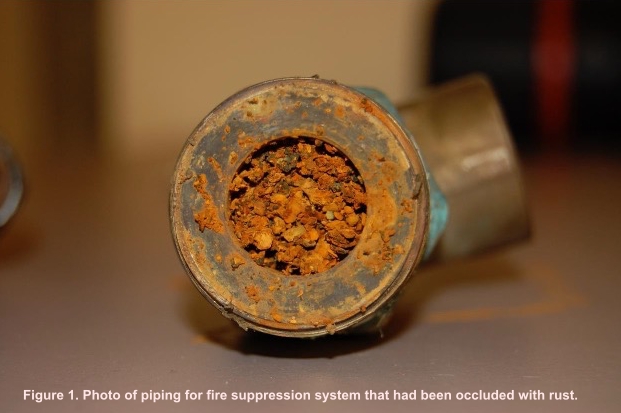 In a multiplace facility one critical area that requires regular maintenance is the fire suppression system. The NFPA requires that the system be functionally tested semi-annually to ensure the flow rate and supply pressure are adequate for the required minimum times. The fire suppression system often has multiple parts and may include, pressurized water supply reservoir, compressed gas supply, pressure reducing regulators, tracking regulators, check valves, quarter turn valves, pneumatic valves, activation systems, flame detectors, alarms, float switches on the water supply, and gauges to name some of the important items, and all these components need a maintenance plan of their own. Often these components will need more frequent maintenance than their counterparts that are found on the gas system due to the potential for rust to contaminate the system. Consideration into monthly refilling of the water reservoir may reduce some of the risk of rust entering the system.
In a multiplace facility one critical area that requires regular maintenance is the fire suppression system. The NFPA requires that the system be functionally tested semi-annually to ensure the flow rate and supply pressure are adequate for the required minimum times. The fire suppression system often has multiple parts and may include, pressurized water supply reservoir, compressed gas supply, pressure reducing regulators, tracking regulators, check valves, quarter turn valves, pneumatic valves, activation systems, flame detectors, alarms, float switches on the water supply, and gauges to name some of the important items, and all these components need a maintenance plan of their own. Often these components will need more frequent maintenance than their counterparts that are found on the gas system due to the potential for rust to contaminate the system. Consideration into monthly refilling of the water reservoir may reduce some of the risk of rust entering the system.
The following section is dedicated to reviewing several of the parts within the fire suppression system individually and identifying why more frequent inspection may be warranted.
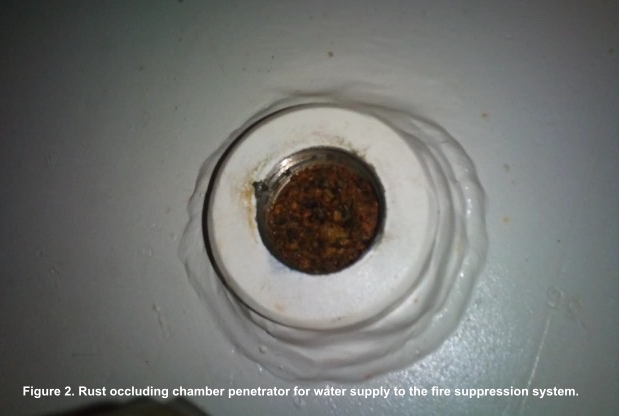 Water supply lines should be periodically checked, especially at elbows and T junctions for accumulation of rust. If sufficient rust is present, it may reduce the amount of water flow per minute. This should be done at various locations between the water supply and the chamber hull and include inside the chamber.
Water supply lines should be periodically checked, especially at elbows and T junctions for accumulation of rust. If sufficient rust is present, it may reduce the amount of water flow per minute. This should be done at various locations between the water supply and the chamber hull and include inside the chamber.
Fire suppression systems will have water supply one way check valves to avoid flow in the wrong direction. Thes valves are comprised of a spring that keeps the valve closed until enough pressure is applied to compress the spring and open the poppet allowing for flow of water. When rust accumulates on the sealing surface of the poppet leaks may occur and sealing of the one-way check valve may not be obtained. Regular inspection of the poppet head should be part of the maintenance prevention plan.
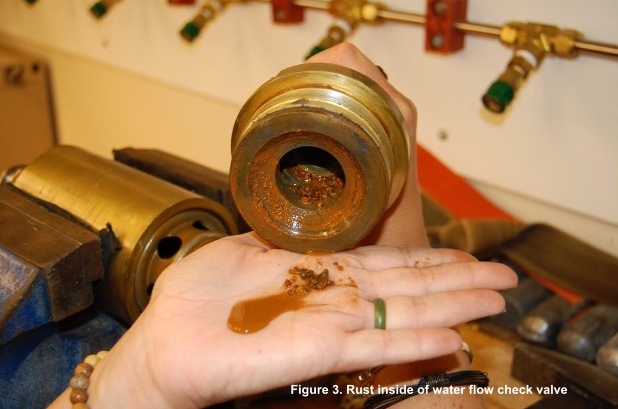 For safety, all chamber penetrators including those for fire suppression should have a shut off valve as close to the penetrator as possible. If the chamber is in Canada this needs to be on both sides of the chamber hull. These are generally ¼ turn valves which are quick operating , requiring only a ¼ turn of the handle to close and easy to identify from the valve handle position if it is in the closed or open position. Inside of the valve is a ball with a hole through it, such that, when open gas/water can flow through and when closed the hole is sealed off by the sealing surfaces on either side. This surface is usually a Teflon seal. Scoring of this sealing surface by rust particles can cause these valves to leak and not be able to isolate the line in the event of a line rupture. For this reason, ¼ turn valves in a water system will need more frequent inspection.
For safety, all chamber penetrators including those for fire suppression should have a shut off valve as close to the penetrator as possible. If the chamber is in Canada this needs to be on both sides of the chamber hull. These are generally ¼ turn valves which are quick operating , requiring only a ¼ turn of the handle to close and easy to identify from the valve handle position if it is in the closed or open position. Inside of the valve is a ball with a hole through it, such that, when open gas/water can flow through and when closed the hole is sealed off by the sealing surfaces on either side. This surface is usually a Teflon seal. Scoring of this sealing surface by rust particles can cause these valves to leak and not be able to isolate the line in the event of a line rupture. For this reason, ¼ turn valves in a water system will need more frequent inspection.
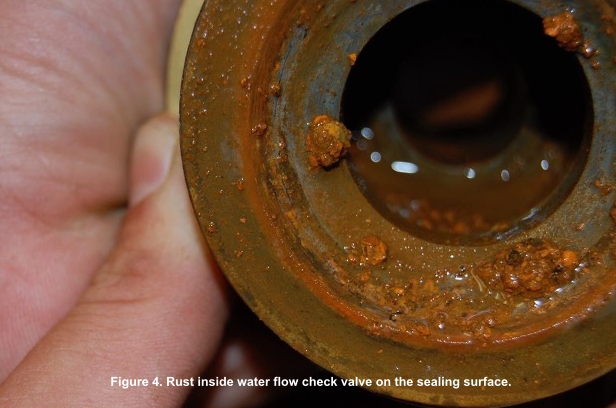 All pneumatically activated valves in the fire suppression system must have a means of manual operation should the air supply fail. This back up manual valve should be function tested and inspected on a consistent schedule.
All pneumatically activated valves in the fire suppression system must have a means of manual operation should the air supply fail. This back up manual valve should be function tested and inspected on a consistent schedule.
Pressure reducing regulators to handlines can also be contaminated by rust and cause the supply pressure to not reach its designed pressure over bottom pressure. This highlights the importance of testing each handline individually as well as ensuring the regulators are inspected at regular intervals.
Should the handline have a spring activated handle to initiate the flow of water, a directional arrow to show the flow of water may be of use to ensure that in the event of emergency activation it is aimed at the flames and not at the person operating it. This will depend on the chamber design, as not all handlines are of this type and directional arrow would not be required.
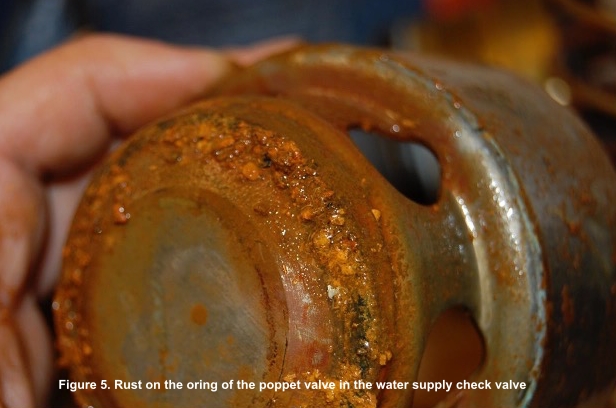 The water supply reservoir must be pressurized to overcome the internal pressure of the chamber. Often this supply system comes with a float switch that will shut off the water supply when the reservoir is low to avoid adding pressurized air to the chamber and causing it to increase depth. The function of this switch should be confirmed to ensure it activates prior to gas being put through the water system.
The water supply reservoir must be pressurized to overcome the internal pressure of the chamber. Often this supply system comes with a float switch that will shut off the water supply when the reservoir is low to avoid adding pressurized air to the chamber and causing it to increase depth. The function of this switch should be confirmed to ensure it activates prior to gas being put through the water system.
Depth gauges should be calibrated and supply pressure gauges function tested on an annual basis and replaced when indicated. These are important to ensure the supply pressure to the suppression system is accurately high enough to overcome bottom pressure and to ensure it is not too high for the system itself which could cause relief valves to fire.
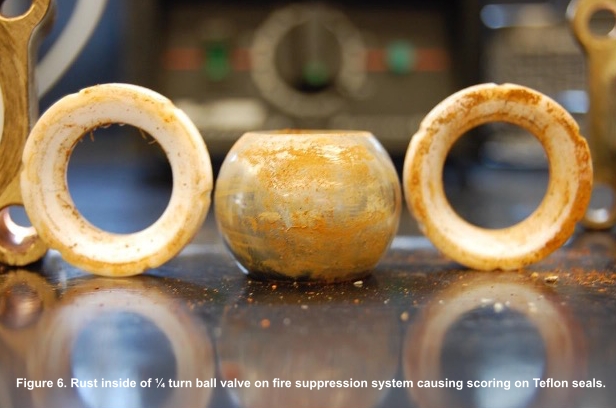 Flame detectors and audible/visual alarms should also be added to the testing schedule. Testing should confirm that bulbs are not burnt out, wiring to audible alarms are functional, and any remote alarms need to be checked that they are not only sounding but that the correct response is being performed by those who it is reaching. Including the building security, local fire, and first responders in your testing of the system is advantageous and often provides opportunity for improvement in the overall fire and emergency response plan.
Flame detectors and audible/visual alarms should also be added to the testing schedule. Testing should confirm that bulbs are not burnt out, wiring to audible alarms are functional, and any remote alarms need to be checked that they are not only sounding but that the correct response is being performed by those who it is reaching. Including the building security, local fire, and first responders in your testing of the system is advantageous and often provides opportunity for improvement in the overall fire and emergency response plan.
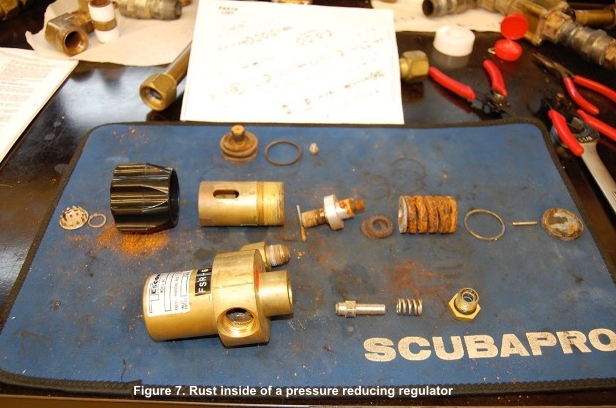 The last part of the preventative maintenance is ensuring that everyone knows how the system is activated and has practiced emergency drills annually. Avoidance of a fire in the first place cannot be overlooked. All electrical systems inside the chamber should have connections and wiring inspected. Ensuring that signage for what not to bring in a chamber is visible, that everyone is checked prior to entering the chamber each time, and that all occupants not only understand what does not go into a chamber but equally importantly why.
The last part of the preventative maintenance is ensuring that everyone knows how the system is activated and has practiced emergency drills annually. Avoidance of a fire in the first place cannot be overlooked. All electrical systems inside the chamber should have connections and wiring inspected. Ensuring that signage for what not to bring in a chamber is visible, that everyone is checked prior to entering the chamber each time, and that all occupants not only understand what does not go into a chamber but equally importantly why.
Preventative maintenance is an imperative part of hyperbaric chamber operations. Knowing that all parts of the hyperbaric system are maintained, up to date, and safe will reduce the likelihood of downtime while the unit is repaired. Proper planning will ensure the parts needed are always on hand. With components such as the fire suppression system, ensuring that testing of the system does not bring you unexpected failure which will render your system inoperable, shutting you down until repaired, can be prevented by regularly inspecting and servicing the components that comprise the system. Thus ensuring potential contamination with rust is dealt with early or avoided all together. All of this will allow the safety director to sleep well at night knowing the system will work in the unlikely event it is ever activated.




















